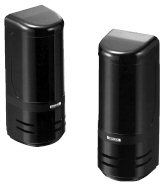Premises Security (part 7) Non-video surveillance
In this next group are the devices which cause the circuit to be broken by detection of a change in the environment rather than through the physical operation of a switch by applied force.
Into this category fall any electronic devices which offer a NO/NC output.
Common instances of such devices include;
Pulsed Infra-red beams, Passive Infra-red movement detectors, Temperature sensors, Smoke sensors, Light/Dark detectors, Proximity devices, but to name a few.
Looking at a couple of these slightly more closely we find;
Description: Pulsed Infra-red barrier beams
(Occasionally referred to as an MIR (Modulated Infra-red) beam)
Operation: A Frequency Modulated light beam of infra-red light (Invisible to the human eye) is sent from a transmitter to a matched receiver. If the signal is interrupted or the frequency of the modulation is altered, the associated electronics will cause an output relay to change state such that the NC becomes NO and the NO becomes NC.
Depending on the design of the beam, the output will return to it's original state when the beam transmission is restored.
Web Reference: http://www.themetalith.com/electronicsecurityfaqs.html#q17
Common Use: Placed across access ways or possible points of entry to detect the passage of people or vehicles.
Connectivity: By connection of a monitored circuit to the NC/C/NO contacts.
Semi-Wireless* models are also available
*These units usually still require a power supply as the transmitters constantly consume quite a bit of current
Description: Passive Infra-red (PIR) movement detector
Operation: An infra-red detector is set-up in conjunction with a series of prismatic reflectors arranged in such a way that as a warm body mass moves in front of the assembly, rapidly changing amounts or infra-red energy are flashed across the IR sensor. The rapidly changing levels are converted into electrical pulses which are measured and counted by the associated digital electronic circuitry. If a pre-defined number of pulses above certain strength are detected within a given timeframe, the circuitry again changes the state of an output relay.
Web Reference: http://home.howstuffworks.com/framed.htm?parent=question238.htm&url=http://www.glolab.com/pirparts/infrared.html
Common Use: Monitoring an enclosed space such as a room for intrusion.
Connectivity: By connection of a monitored circuit to the NC/C/NO contacts.
Wireless models are also available
Description: Proximity detector
Operation: Often based upon detecting a change in capacitance of the surrounding environment, these devices operate on a ‘tuned-capacitance’ principle whereby they “observe” the unchanging capacitance of the space (room) and set this as their baseline. When a body enters that “tuned” space, it de-tunes the capacitance of the monitored area and that change is detected by the proximity monitor.
Like other electronic sensors, the changing levels are converted into electrical pulses which are measured and counted by the associated digital electronic circuitry. If a pre-defined number of pulses are detected within a given timeframe, the circuitry changes the state of an output relay.
Common Use: Monitoring an enclosed space such as a room for intrusion.
Connectivity: By connection of a monitored circuit to the NC/C/NO contacts.
Into this category fall any electronic devices which offer a NO/NC output.
Common instances of such devices include;
Pulsed Infra-red beams, Passive Infra-red movement detectors, Temperature sensors, Smoke sensors, Light/Dark detectors, Proximity devices, but to name a few.
Looking at a couple of these slightly more closely we find;
Description: Pulsed Infra-red barrier beams
(Occasionally referred to as an MIR (Modulated Infra-red) beam)

Operation: A Frequency Modulated light beam of infra-red light (Invisible to the human eye) is sent from a transmitter to a matched receiver. If the signal is interrupted or the frequency of the modulation is altered, the associated electronics will cause an output relay to change state such that the NC becomes NO and the NO becomes NC.
Depending on the design of the beam, the output will return to it's original state when the beam transmission is restored.
Web Reference: http://www.themetalith.com/electronicsecurityfaqs.html#q17
Common Use: Placed across access ways or possible points of entry to detect the passage of people or vehicles.
Connectivity: By connection of a monitored circuit to the NC/C/NO contacts.
Semi-Wireless* models are also available
*These units usually still require a power supply as the transmitters constantly consume quite a bit of current
Description: Passive Infra-red (PIR) movement detector

Operation: An infra-red detector is set-up in conjunction with a series of prismatic reflectors arranged in such a way that as a warm body mass moves in front of the assembly, rapidly changing amounts or infra-red energy are flashed across the IR sensor. The rapidly changing levels are converted into electrical pulses which are measured and counted by the associated digital electronic circuitry. If a pre-defined number of pulses above certain strength are detected within a given timeframe, the circuitry again changes the state of an output relay.
Web Reference: http://home.howstuffworks.com/framed.htm?parent=question238.htm&url=http://www.glolab.com/pirparts/infrared.html
Common Use: Monitoring an enclosed space such as a room for intrusion.
Connectivity: By connection of a monitored circuit to the NC/C/NO contacts.
Wireless models are also available
Description: Proximity detector
Operation: Often based upon detecting a change in capacitance of the surrounding environment, these devices operate on a ‘tuned-capacitance’ principle whereby they “observe” the unchanging capacitance of the space (room) and set this as their baseline. When a body enters that “tuned” space, it de-tunes the capacitance of the monitored area and that change is detected by the proximity monitor.
Like other electronic sensors, the changing levels are converted into electrical pulses which are measured and counted by the associated digital electronic circuitry. If a pre-defined number of pulses are detected within a given timeframe, the circuitry changes the state of an output relay.
Common Use: Monitoring an enclosed space such as a room for intrusion.
Connectivity: By connection of a monitored circuit to the NC/C/NO contacts.


0 Comments:
Post a Comment
<< Home